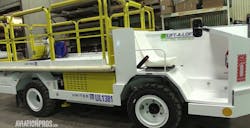Hawker Beechcraft Corporation Goes Higher, Farther and Faster with the New Premier II
GENEVA , May 19 /PRNewswire/ -- Hawker Beechcraft Corporation (HBC) today launched the newest member of its legendary family of capable, comfortable, reliable and efficient jets -- the new Beechcraft Premier II light business jet. Evolving from the highly successful Premier IA, the Premier II will feature higher cruise speeds, a 20 percent longer range with four passengers and an increased payload while still offering the largest cabin and most technologically advanced single-pilot business jet in the world.
(Photo: http://www.newscom.com/cgi-bin/prnh/20080519/NYM093 )
(Logo: http://www.newscom.com/cgi-bin/prnh/20070322/HBLOGO )
"For 75 years, our company has been on the forefront of private and business jet aviation," said Jim Schuster , Hawker Beechcraft chairman and CEO. "The Beechcraft Premier II will redefine the light jet market and take it to a new level in meeting customer expectations. With its unmatched performance and efficiency, impressively spacious cabin and advanced technology, the Premier II is a natural choice for business and private travelers who want to travel in comfort and get to their destination quickly."
The Premier II will be a twin turbofan, swept wing, light jet aircraft featuring a high-strength, state-of-the-art all-composite fuselage that allows for a medium-jet sized cabin at light jet costs. Featuring luxurious and comfortable standard seating for up to six passengers and their baggage, the Premier II will deliver more people to more locations, more efficiently and in more comfort than any other light jet.
Enhanced Performance
At the heart of these major aircraft advancements will be a pair of FJ44-3AP turbofan engines, the newest member of the Williams International engine family. These highly efficient, ultra powerful engines will produce 6,000 pounds of combined thrust -- an increase of more than 23 percent from the Premier IA. Combined with new elliptical winglets, the new-generation engines will allow the Premier II to climb higher to an unrestricted, chart-topping maximum cruising altitude of 45,000 feet (13,716 m) and fly farther -- a 1,500 nm (2,778 km) mission with one pilot and four passengers. The 4,000-foot operating ceiling boost also puts passengers well above most traffic and weather, allowing them to enjoy the smoothest ride and arrive at their destination faster. Simply put, the Premier II will save owners and operators time and money.
The higher thrust engines will also improve high/hot take-off operations and increase maximum cruise speed to 465 knots (861 km/hr) at typical cruise altitudes. The time to climb to FL370 will improve from 17 minutes to 14 minutes, ensuring more efficient ATC operations and direct routing. The maximum gross take-off weight (MGTOW) will also increase from the 12,500 pound (5,670 kg) limit found on the Premier IA to 13,800 pounds (6,260 kg), allowing operators to carry more than 900 pounds of payload with full fuel. More payload and range mean more flexibility and capability for owners without the higher acquisition and operating costs of a larger jet.
"The Beechcraft Premier IA is the fastest large-cabin, single-pilot business jet in production today, and the Premier II will be even better. Our program objective was all about improving the performance of our exceptionally successful Premier IA," said Brad Hatt , president, Commercial Aircraft. "The Premier II takes everything that operators love about the Premier IA and improves upon it to create an aircraft that will deliver the performance and capabilities of a much larger jet while providing the economy and efficiency of a light jet. The result is an aircraft that can fly further, faster and higher than ever before."
Cockpit Changes
While the Premier II's cabin will pamper passengers with luxury and comfort, its cockpit will deliver an advanced level of operational sophistication and situational awareness -- just what one would expect in a jet designed to be flown single-pilot. The Premier II's flight deck will be fine-tuned to accommodate a new 3-in-1 Electronic Standby Instrument System (ESIS), FADEC control switches, VHF Comm ground switch and avionics integration of the standby COMM/NAV controller.
Manufacturing and Certification
Elliptical shaped winglets, crafted of lightweight, ultra strong composites, will be installed to enhance aerodynamic performance. The Premier II's winglets contribute to the aircraft's long list of performance advantages. The winglets offer reduced drag and an increased effective wingspan without actually lengthening the wings, enabling the Premier II to fly farther than its predecessor. The custom designed winglets were sized to provide distinct performance improvements while not impacting airframe inspection schedules.
The improved capability is also largely due to the Premier II's certification in accordance with 14 CFR Part 23 Commuter Category thru Amendment 23-57, which will include new engines specified in compliance with the environmental aircraft pollution standards. First flight of the aircraft is scheduled for April 2009 with FAA Certification planned for Q2 2010. European Aviation Safety Authority (EASA) certification is expected in Q4 2010.
Hawker Beechcraft Corporation is a world-leading manufacturer of business, special-mission and trainer aircraft -- designing, marketing and supporting aviation products and services for businesses, governments and individuals worldwide. The company's headquarters and major facilities are located in Wichita, Kan. , with operations in Salina, Kan. ; Little Rock, Ark. ; and Chester, England , U.K. The company leads the industry with a global network of over 100 factory-owned and authorized service centers. For more information, visit http://www.hawkerbeechcraft.com .
This release may contain "forward-looking statements" within the meaning of Section 27A of the Securities Act of 1933 and Section 21E of the Securities Exchange Act of 1934. All statements, other than statements of historical fact, including statements that address activities, events or developments that we or our management intend, expect, project, believe or anticipate will or may occur in the future are forward-looking statements. Forward-looking statements are based on management's assumptions and assessments in light of past experience and trends, current conditions, expected future developments and other relevant factors. They are not guarantees of future performance, and actual results may differ significantly from those envisaged by our forward- looking statements. Among the factors that could cause actual results to differ materially from those described or implied in the forward-looking statements are general business and economic conditions, production delays resulting from lack of regulatory certifications and other factors, competition in our existing and future markets, lack of market acceptance of our products and services, the substantial leverage and debt service resulting from our indebtedness, loss or retirement of key executives and other risks disclosed in our filings with the Securities and Exchange Commission.
SOURCE Hawker Beechcraft Corporation





